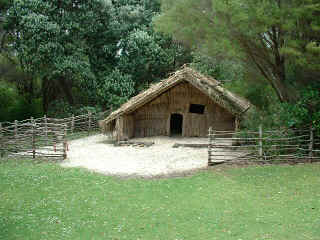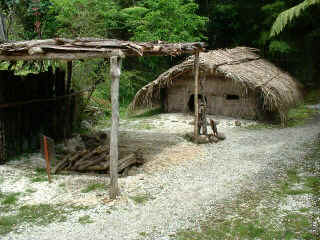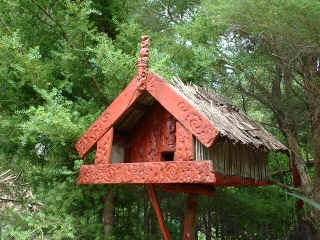
|
Rewa's village is a replica of a pre-European Maori fishing
village, a kainga. Typically there would be several kainga in an area usually sited beside
a fresh water supply and adjacent to fishing or shelling grounds, cultivation or hunting
grounds. Kainga would usually be in the vicinity of a fortified pa on a headland, hilltop
or ridge, such as the Kororipo Pa across the Kerikeri river, which would be a refuge when
enemy raiders approached.
The marae, an open space in front of the chiefs house (whare), is where most of the
village activities would take place; welcoming ceremonies, discussions, dancing and
recreational activities. The largest house in the village is the whare of the chief,
kaumatua, and his family. |
Since whare (pronounced far-ay) were used mostly for sleeping or in
adverse weather conditions, they were usually small with low doorways to conserve warmth.
Larger houses might have a window and fireplace with the smoke making its way through the
thatch, door and windows. Beds were of bracken or mangemange fern, the walls of raupo (a
kind of reed) and thatch of nikau (an indigenous palm).
The shelter covers the cooking area. There were many tapus surrounding food in
Maori culture and it could not be kept, cooked or eaten inside a dwelling house. Fire was
started by rubbing a stick along a flat piece of wood until friction would start the wood
shavings smoldering. Food was cooked in an earth oven (hangi). |

|

|
The red ochre decorated hut, perched on top of a 8 foot pole, is
the tohungas (priests) pataka where he would store his sacred objects. The
tohunga was an expert in various aspects of Maori life - canoe building, tattooing,
carving, house building, medicine and religious practices. He was the conserver of Maori
lore. To protect the contents the pataka would be made tapu by the tohunga, indicated by
the red ochre paint. |
|
 S/V
TETHYS
S/V
TETHYS S/V
TETHYS
S/V
TETHYS